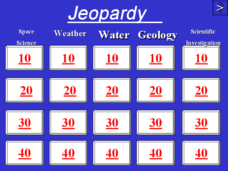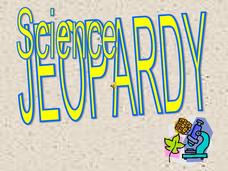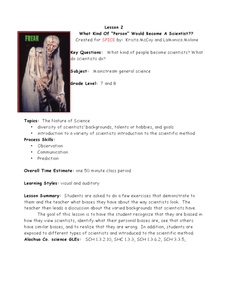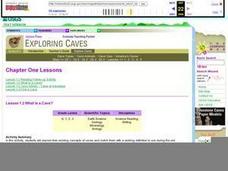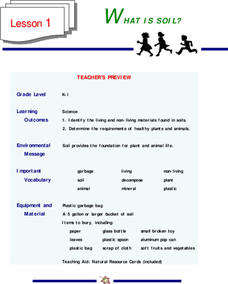NOAA
The Great, Glowing Orb What You Will Do: Make a Solar Heat Engine
How is solar energy able to move wind and water to control the climate? Scholars explore the concept of solar energy in the first of 10 activities in the Discover Your Changing World series. They follow instructions to build homemade...
University of Southern California
What Lives In The Ocean?
One of the most diverse environments on Earth is the ocean. Young scientists explore the living things found in the ocean during an exciting seven-lesson unit. Their study includes organisms from plankton to invertebrates...
Howard Hughes Medical Institute
The Proteasome and Protein Regulation
What is a proteasome? Like tiny trash compactors inside cells, proteasomes turn worn-out proteins into reusable amino acids! Explore the topic with a presentation and embedded simulations. The resource includes a teacher's reference and...
Curated OER
Where Is Our Food Grown?
Students view the Interactive Whiteboard's supermarket and discuss what they can see there. They watch the animation about where food comes from and discuss any questions they may have. They then are introduced to the "Farm Alarm" game...
Beyond Benign
The Heat Is On
Explore an exothermic reaction with a quick lab investigation. The activity builds on the previous lessons by examining an ingredient in many shampoos. Scholars record temperature data as sodium hydroxide and water interact.
Community Resources for Science
"5 E's" Science Planning Worksheet
This two-page planning guide walks you through a five-part process for teaching scientific content. To begin, decide how you will evaluate learners' progress, then what tools you will use to engage them in the topic. Plan how they will...
Curated OER
Lesson Idea: A Box Full of Science
Students analyze and study a shoe box of simple objects. They experience a homemade alternative to a company box of commercial kits for science. Each student creates their own shoe box of simple objects to share with their classmates.
Curated OER
What is Motion?
Prior to beginning a math or physical science lesson on motion, use this presentation to define the concepts of motion, rate, velocity, and speed. This resource lacks concrete examples but could be useful as discussion starter.
Curated OER
What is a Class One Lever?
Fifth graders understand what a lever is, how it works and what the parts of a lever are. In this first class lever instructional activity, 5th graders label pictures and design a lab lever. Students predict the outcome of experiments...
Curated OER
Jeopardy - Earth Sciences
Questions about water, weather, geology, astronomy, and the scientific process make up this Jeopardy game. It is a pretty well-rounded set of slides, although you may want to be aware that a few of the questions are specific to the state...
Curated OER
Science Jeopardy
Make reviewing evolution, cell division, genetics, cell structure, and scientific method more fun! Science Jeopardy allows teams to choose a category for the question they will address. If you complete the entire game, learners will have...
Curated OER
What Kind of "Person" Would Become a Scientist?
"Scientist Stereotypes" could be another name for this lesson! Begin by drawing from middle schoolers' preconceived notions and media portrayal of scientists, and then explain that anyone can be a scientist. Even though there is an...
Curated OER
What is the Rock Cycle and Its Processes?
Geology beginners examine three different rock samples and determine their origin by their characteristics. By making and recording observations, they become familiar with features of igneous, metamorphic, and sedimentary rock types....
Curated OER
What Makes a Plant a Plant?
For a plant unit in your biology curriculum, here is a slide show that bestows the basics of plant structure, reproduction, and classification. The information is general. The main point of the lesson is to highlight what characterizes...
Curated OER
What is a Seed?
Students share experiences they have had with different types of seeds. After being read a story, they are given a lima bean in which they split apart and examine the inside. To end the lesson, they share their own ideas on how they...
Curated OER
What Is A Cave?
Students explore their existing concepts of caves and match them with a working definition to use during the unit. They name the two types of rock formations in which most American caves occur, and define "show cave" and "wild cave."
Curated OER
Is Anyone Out There? Examining Astrobiology and the Value of SETI
Blow their minds with a lesson plan on the search for life outside of our planet! A brief video proposes the question of how to define life. A couple of articles investigate the possibility of alien existence. Finally, the class is...
Curated OER
What is Energy?
Youngsters take a look at the foods they eat, and how they provide energy for them to do things. They look at how body uses the food energy to create movement. Pupils also look at toys/devices in the room that need electrical energy...
Curated OER
What is a Hurricane?
Middle schoolers research hurricanes on the Internet. In this hurricane lesson, students use the Internet to find out the basic shape of hurricane winds and classify three characteristics of hurricanes. Middle schoolers then classify at...
Curated OER
What Should I Know about Respiration
How are kids supposed to know what to study for that cellular respiration test? With a study guide or reading guide like the one found here. With three pages of questions important to the understanding of respiration and the processes...
Curated OER
What Should I Know about Biosphere?
If your class is learning about the biosphere, you may find a study guide or reading guide helpful. Focusing on vocabulary, processes, and interactions, the Word document is easy to edit as needed to fit your needs. Another great...
Curated OER
What Should I Know About Photosynthesis
This four-page handout would work great as a reading guide or note-taking resource for teens learning about ATP, photosynthesis, the key scientists in the realm of photosynthesis, and more. It is designed to accompany a certain textbook,...
Curated OER
What is Soil?
Pupils study living and non-living materials that are found in soil. They study the things required by plants and animals to remain healthy. They design a collage of sand, stones, leaves and other natural items.
Curated OER
What Is An Insect?
Students find and classify insects. They collect insects, study them with a hand lens and identify its body parts. Afterwards, they discus various types of insects and thier Orders such as beetles, butterflies and moths, grasshoppers, etc.
Other popular searches
- What Is Science
- What Is Science?
- What Is Earth Science
- What Is Environmental Science
- What Is Science Important
- What Is Physical Science
- What Is Life Science
- What Is Science Worksheets
- What Is Work in Science
- What Is Science Fiction
- What Is Earth Science?
- What Is Science Worhsheets









